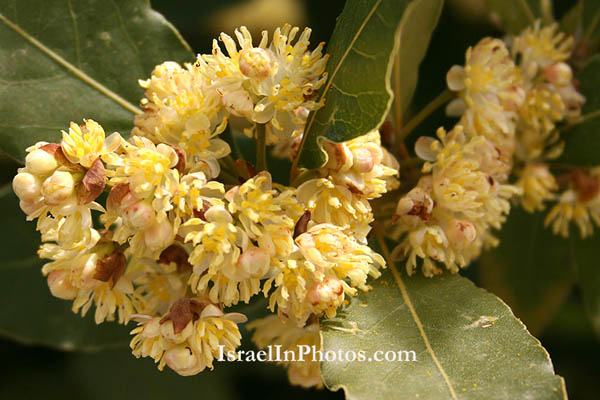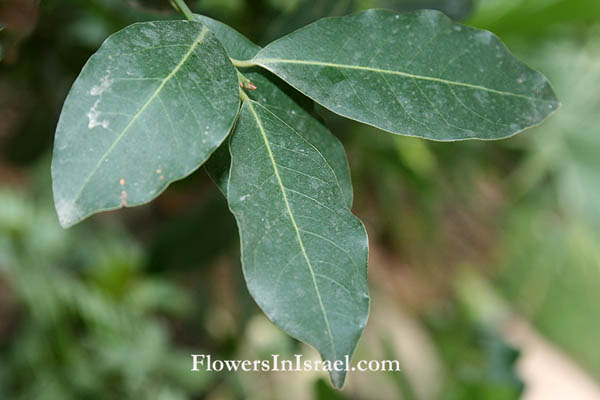Hebrew: ער אציל, Arabic: نبات الغار
| Scientific name: | Laurus nobilis L. | |
| Common name: | True Laurel, Sweet Bay | |
| Hebrew name: | ער אציל | |
| Arabic name: | نبات الغار | |
| Plant Family: | Lauraceae, עריים |

|
| Life form: | Phanerophyte, tree | |
| Stems: | 7.5m or more; smooth, olive green to black bark; very slow growing | |
| Leaves: | Alternate, entire | |
| Inflorescence: | An axillary cyme or raceme of small pale yellow flowers | |
| Flowers: | Dioecious, pale yellow with 4 petals fused at the base; female flowers, few, superior ovary with one loculus; male flowers, numerous, usually 10-12 stamens which are attached to the corolla | |
| Fruits / pods: | Drupe, small, shiny black berries about 1 cm long | |
| Flowering Period: | March, April, May | |
| Habitat: | Mediterranean maquis and forest | |
| Distribution: | Mediterranean Woodlands and Shrublands, Montane vegetation of Mt. Hermon | |
| Chorotype: | Mediterranean | |
| Summer shedding: | Perennating |

Derivation of the botanical name: Laurus, laurel. nobilis, notable, famous. The Hebrew name: ער, ar is in the Talmud, the plant is referred to as "Trepa Dera" in Aramaic. The Latin name of the genus ar, Laurus (awake), derives from the name of laura which means a place of monasticism for monks.
quote from Homeric Hymn To Dionysus, (Homer, Greek - Hómeros, 800 BC - 700 BC) Daphne, a Naiad nymph, was loved by the god Apollo who pursued her until she grew exhausted, cried out to Gaia for help and was transformed into a laurel tree. A Laurel wreath, sacred to Apollo, from the city of Tempe, in Thessaly, was the award for the Pythian games, one of the four Panhellenic Games of Ancient Greece, held every four years at the sanctuary of Apollo at Delphi. The games hosted poetry and music competitions besides the staple of athletic events. The musical disciplines included:
Pliny the Elder, Gaius or Caius Plinius Secundus, (23CE –79 CE) wrote in Naturalis Historia: "The tree was especially reserved for triumphs and is certainly much favoured in houses; it is the guardian of the doorways of emperors and high priests, where it hangs alone adorning their homes and keeping a vigil before the treshold. Visitors to Delphi are crowned with laurel, as are generals celebrating a triumph at Rome. The laurel itself is a messenger of peace, inasmuch as holding out a branch of laurel, even between enemy armies, is a sign of a truce". The dried leaves of the Laurus nobilis are an important ingredient of both sweet and savory dishes in European cuisine. Leaves are used in packing dried figs and licorice in order to deter weevils. In Israel the Laurus nobilis is a constituent of the Common Oak Forest (Quercus calliprinos) See the list of Medicinal herbs in Israel, the parts used and their medical uses to treat various diseases. Symbolism: Bay laurel, cultivated throughout the Mediterranean basin, was one of the most important symbolic plants for the Greeks and Romans. Bay leaf crowns were symbols of wisdom and glory for athletes and emperors. Zohary (1982) noted that this tree was particularly esteemed by the ancient Greeks, whose heroes were adorned with laurel garlands. Bay laurel leaves are evergreen and have a pleasant spicy fragrance. Elmes (1826) and Moltke (1952) (based on Pliny) suggested that that these features may explain why Greeks and Romans used bay laurel leaves to adorn the brows of their priests, poets, and heroes, including the victors in the Pythian and Olympian Games. Similarly, bay laurel was a mark of distinction for certain high offices and political functions. In addition, Elmes (1826) noted the use of laurel as a kind of ancient medal. Bible resources:
|